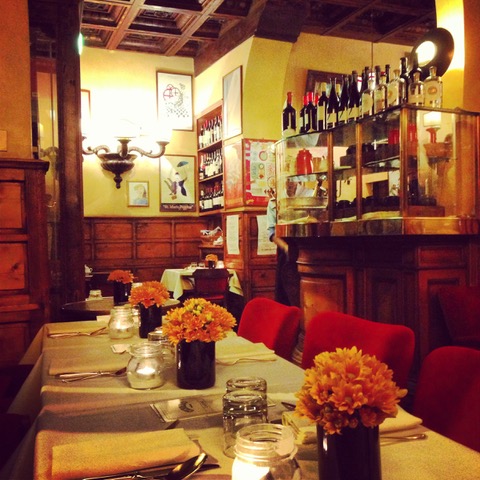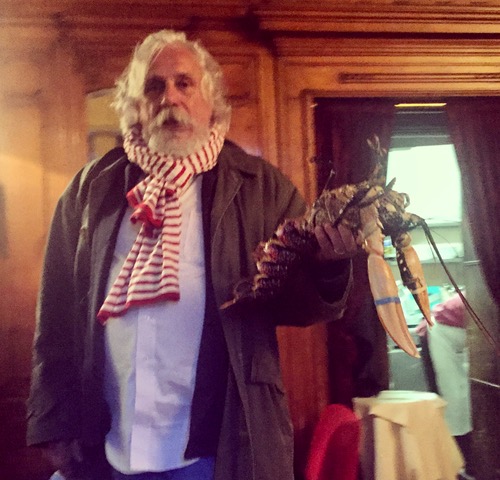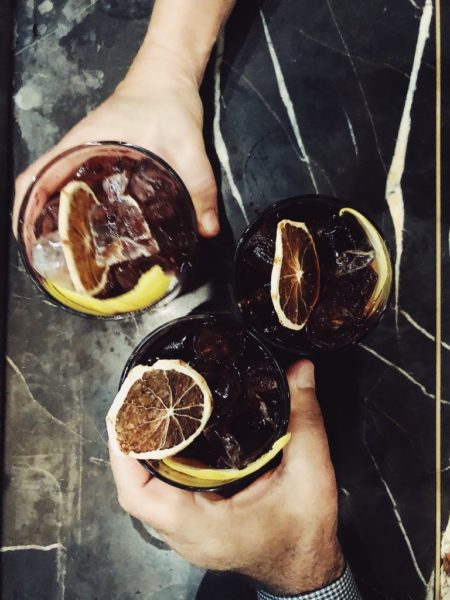On a rainy day in May,
I stepped into Cibreo Café
after eating at the Teatro
with friends from Santa Fe.
There was nothing more for me to eat and nothing more that I could drink. But I could not pass by Cibreo without un salutino. The café is a world of its own, a vortex that draws me like a favorite chair.
I come home to myself just by stepping in the door. The barman and waiter are standing in the doorway discussing politics, something close to religion here. They greet me kindly to come in.
“Un caffe? Un te? Cosa voi?” Isidoro asks.
“Niente. Grazie,” I say.
I’m too full to consume anything. I just want to stand here for a minute, soaking up its familiarity. I often visit in the afternoon, when there are hardly any customers, to sit and write, read or talk to a friend. But today I am simply passing.
Isidoro says, “Questo posto e un uscio e bottega.” Uscio e Bottega, a Florentine expression for “home away from home.” E come casa: like home, but also a place of business. He says cafés were originally conceived as places where people could relax, read the paper, drink a coffee and have a taste of something. They were made to be places of belonging outside of the house, in community, where passing a few hours, conversations about politics, children, the weather, was the norm.
“Now,” he says, “people hardly have time to stop. They are in a rush. No time to stop and talk, much less savor a taste.” Dreadful, I think. Surely it’s our (fast-paced American) fault. Do we all want such a place to go? Or just certain types of people?
 Cibreo’s interior is lined with dark wooden wainscot half-way up the walls, with butter yellow paint to the ceiling, which is unusually carved with dark wood protuberances and flecks of gold. The floor is chestnut and looks like it’s been there for centuries. It creaks when you walk on it. All doors, windows and wood slabs were recycled from churches and villas from the surrounding country- side. The café looks and feels like it’s been there 100 years, but really only 30.
Cibreo’s interior is lined with dark wooden wainscot half-way up the walls, with butter yellow paint to the ceiling, which is unusually carved with dark wood protuberances and flecks of gold. The floor is chestnut and looks like it’s been there for centuries. It creaks when you walk on it. All doors, windows and wood slabs were recycled from churches and villas from the surrounding country- side. The café looks and feels like it’s been there 100 years, but really only 30.
 Small round tables are covered in cream-colored cloths. Fresh yellow daisies grace a vase on each. Red velvet theater chairs, whose seats go up and down, offer an inviting touch of elegance. I sink into a chair and become a hedonistic phlegmatic, not wanting to move but to sit and sip and chew, complacent and happy, steady as a tree trunk, drunk on the ecstasy of that moment.
Small round tables are covered in cream-colored cloths. Fresh yellow daisies grace a vase on each. Red velvet theater chairs, whose seats go up and down, offer an inviting touch of elegance. I sink into a chair and become a hedonistic phlegmatic, not wanting to move but to sit and sip and chew, complacent and happy, steady as a tree trunk, drunk on the ecstasy of that moment.
From where I sit, each arriving customer begs study, whether morning, noon, afternoon or night.
The cappuccini and caffé latté contain the perfect balance between milk and coffee. Coffee is tapped just so in the bowl, pressed with the right amount of force for the right amount of seconds, then hooked into the machine. The crema comes out perfetta, milk steamed just so for the consistency of foam. These things are not as simple as they sound.
I can’t really drink coffee. I love it, but it doesn’t love me. I don’t miss it until I am in the cafe and notice Isidoro’s modo di fare. His way of making it.
Standing in Cibreo’s doorway, a flood of memories come. I am reminded of how many meals I have eaten here. How many times I’ve heard the menu read to me, out loud like poetry, though I already knew each dish by heart.
“Crème of yellow pepper soup”
“Zuppa di pepperoni gialla… ”
“La Polenta cremosa con burro sfuso e Parmigiano Reggiano sopra”
“La Parmigiana”
“Zuppa di pesce piccante”
“Baccala monticato”
“polpettine con una salsa Livornese”
“Salsiccia e fagioli”
“Inzimino”
“Budino di cioccolato”
“Baverese con salsa di fraggole.”
I can taste these dishes in my mind. How many sunny seasons have I sat outside, watching the chefs move back and forth from restaurant to café and now to the Theater? How many cool days have I sat inside with a glass of red wine over a heated conversation? With or without company, I am happy to sit, often staring out the window to the striped awning across the street, “Ristorante Cibreo da 1986. Via del Andrea Verrocchio, 11.”
No matter how it’s framed, from the doorway, or the window, this awning appears to me as a sign of affection. No lover has lasted as long or won my affection as deeply. An alignment of the senses are arranged and balanced. It resonates as a temple, not of worship, but something closer to simple human aesthetic satisfaction. I’ve been coming to this door for over 20 years. I remember old entrances, old kitchens, old personnel. And Franca, the female rock of Cibreo.
Franca had a funny way of welcoming, but welcome she did. “Oh Peggy! where have you been? In Portugal dancing with the King?” She was a chiacherone—someone who talked constantly, greeting everyone who came through the door, often with nicknames. Regulars like “Chamomila,” the short, round, bald man, well-dressed with a sweater thrown just-so around his neck, who stopped by for a martini every day at 10 am. Franca reminded me of the timeless barmaids of yore. Tightly dressed, hair coiffed, with perfect makeup. From her pulpit bar, Franca spouted Florentine philosophy in her Fiorentino accent, orchestrated caffé, cappuccini, martinis, bicchiere di vini, panini, biscottini, all the while joking with everyone and keeping the barman on his toes. We loved her for it. In a way, she was un punto di referimento, a point of reference, not only for the people of the neighborhood, but for the family who worked at Cibreo.
Her sudden passing at 63 was shocking. Franca was not well, but we didn’t realize how unwell. She orchestrated even her own demise. We lost her to the Arno River. Her comedy in the end; a tragedy.
And then, there is Yumi, slight and Japanese, agile with a great smile. Abrazac, the Moroccan pasticierra, whose consistency in holding the note for the beloved dolce is still alive and well. Alfonso, who’s charming Pugliese curls and mysterious demeanor has graced the grounds of the restaurant for half his life. He knows what you need before you do, having a 6th sense for most things, especially reading people. He once put a tiny sliver of flourless chocolate cake in front me before the thought that I wanted it, which I did, fully entered my mind.
 And then, there is Fabio Picchi. The mastermind and chef owner of it all. He’s a character bigger than life, a Marx look alike and a Socialist to boot. No detail goes unseen in his kitchens. There is little time to waste on mediocrity.
And then, there is Fabio Picchi. The mastermind and chef owner of it all. He’s a character bigger than life, a Marx look alike and a Socialist to boot. No detail goes unseen in his kitchens. There is little time to waste on mediocrity.
Fabio falls in love with everything he sees, reads and tastes or…doesn’t. If he does, he uses the kindest touch to bring whatever it may be alive with affection. The restaurant, the trattoria and the café are like his grown children. The new Teatro del Sale, is his baby with his wife, comic actress Maria Cassi. This is where you will find him, yelling out the upcoming dishes for the buffet from the kitchen window. Unless you are up at 6 in the morning at the market, or you catch a glimpse of him making the triangle rounds between restaurant, café and Teatro.
The café is a place for the amuse buche, Something to amuse the palate. Throughout different times of the day, there are delectable things to choose from, like, the doughnut called Frate, first made by monks and perfected by Abrazac. Their cake-like consistency holds up beautifully to be “dipped” not “dunked” into the consummate cappuccino. The panini, some so small they look the size of an egg, cut in half with butter and anchovies. Schiacciata so thin you can’t imagine how anyone cut it to lay a slice of mortadella in between.
One stands to enjoy these ‘bites’ at the bar with a glass of prosecco, or vino, a little small talk, then via. Sensible fast food, not taken away, but enjoyed on the spot.
The Aperitivo? Adoro! It is my early evening meditation. If only I could be so dedicated to sit on my meditation cushion as devotedly. A crisp divine white wine, poured into a tall crystalline glass sends me. It comes to the table, not with ‘pattatine’ (Italian potato chips cooked in olive oil and sprinkled with sea salt) which I love, but ‘pizzette’, tiny pizza’s only big enough for a bit of sauce and a few capers. They come on a long plate with shiny black olives, and thin fried crisps of chick pea crackers laced with garlic.
 In summer I acquiesce to gin and tonic or to the “negroni”. A strong ‘alcolico forte!’ ma buonissimo. Candy is dandy, but liquor is quicker. Allegria to the rescue, forcing any sense of negative emotion way beyond the front lines. Two would be deadly and most unladylike, although rules are made to be broken. Nothing to me is more civilized than a proper aperitivo. I bow to the Italians for making this ritual one of the best ingredients for ‘la dolce vita’.
In summer I acquiesce to gin and tonic or to the “negroni”. A strong ‘alcolico forte!’ ma buonissimo. Candy is dandy, but liquor is quicker. Allegria to the rescue, forcing any sense of negative emotion way beyond the front lines. Two would be deadly and most unladylike, although rules are made to be broken. Nothing to me is more civilized than a proper aperitivo. I bow to the Italians for making this ritual one of the best ingredients for ‘la dolce vita’.
Florentines flow in and out of the bar. They greet each other casually, one looking more fine than the next. People-watching here is like looking at a a fashion magazine, but better. It’s alive. The style is understated, chic, and like no other.
This is not Hollywood. There is no bling. But there is balance. It’s what you call, “taste”- an eye for quality and detail. It doesn’t hurt being drop dead handsome or beautiful with lovely olive skin, refined as Michelangelo’s sculpted marble.
Not all Florentine’s are or have been good looking. One look at Dante or the Medici’s and you understand the gene pool, but ‘intelligente da morire’. The character and the way these people carry themselves, so confident, intelligent and interesting, comes from centuries of sophistication.
I for one, do not come from such unless I was here ‘once before’. But I feel at home here, a ‘Fiorentina finta’: a pretend Florentine. Especially inside my ‘usho bottega’.
